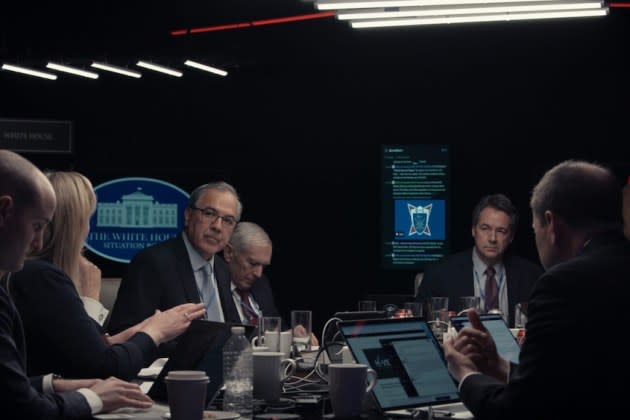‘War Game’ Review: An Intense Documentary Maps Out What the Next Jan. 6 Might Look Like

The nerve-wracking documentary “War Game” follows a 6-hour Situation Room re-creation of events of Jan. 6, 2021, albeit on a larger, more distressing scale. In the process, the film lays bare numerous weaknesses in America’s political infrastructure, but its most revealing subjects might not be who you think.
Directors Tony Gerber and Jesse Moss strip their opening scenes of context, as they follow two former U.S. soldiers in Washington, D.C. Dressed in tactical gear, they survey the U.S. Capitol and avoid the watchful eyes of police while discussing where they might attack. The conversation is concerning, but it’s soon revealed that these men — Chris Jones of the Marine Corps and Kris Goldsmith of the U.S. Army — are merely tacticians in a roleplaying game. However, once the full scope of their experiment fades into view, “War Game” becomes perturbing all over again.
More from Variety
Oscar Winner Alex Gibney Talks Learning to Lean In, Paul Simon and How to Reengage With Viewers
'The Bones' Review: It's Paleontologists vs. Profit in Entertaining Look at the Fossil Trade
'Balomania,' 'KIX' Filmmakers on Ethics of Filming Protagonists on Society's Margins
The seeds for this game — designed by non-partisan group Vet Voice — were planted when the Washington Post published a 2021 op-ed by three retired generals that argued “the military must prepare now for a 2024 insurrection.” To guarantee a realistic government response, Vet Voice casts its characters from among real-world politicians and intelligence heads, and has them play out an insurrection scenario in a makeshift Situation Room for six hours, without a script in hand.
Former Montana governor Steve Bullock plays incumbent President John Hotham, while his cabinet and intelligence appointees consist of real military and government personnel. They make up the first of the game’s three “pillars,” though they have little say in its planning. All they can do is respond as the scenario unfolds, while bright red digital clocks count down all around them. At various intervals, videos depicting an extremist Presidential candidate and his military loyalists stream onto their screens, as social media posts about ongoing unrest are typed and sent by Jones and Goldsmith next door. (It could be a prequel to Alex Garland’s “Civil War.”)
The aforementioned duo, dubbed the “Red Cell,” form the game’s second pillar, as experts on the subject of white supremacist misinformation. Using pre-recorded doctored videos, they play members of the Order of Columbus, a group of insurgents modeled on QAnon and the Oath Keepers, whose actions force the fictitious White House to keep pace with evolving online narratives. The game’s third pillar, the “White Cell,” comprises producers and showrunners, who lay out the rules and directives over headsets, while providing updates on angry mobs marching not only in Washington, but nationwide.
The camera intimately follows Hotham and his cabinet, but the way they’re presented imbues the game with a bizarre un-reality. Voyeuristic long lenses peer in on their meetings, but the frame’s visual contrast is set so low that these politicians often appear muddy and gray. Against the deep black backdrops around them — the game is staged like a piece of black box theater — this lack of contrast surrounds the players with digital halos, as if they’d been awkwardly pasted into the space. They feel like intruders or impersonators, rather than real cabinet members.
Intentional or otherwise, this visual glitch — coupled with frequent cutaways to the organizers outside — prevents immersion into the game’s reality. However, this artifice soon becomes the movie’s point. Onscreen text denoting real names and ranks serve as reminders that these actors are, in fact, improvising from a place of real-world experience, which makes it all the more chilling when their responses fall short.
Like the auditioning actors in Kitty Green’s true crime documentary “Casting JonBenet,” the performers brings their own experiences and anxieties to the part. But as engrossing as the game may be, the stories of its game masters are just as vital. For Jones, examining military extremism is no incidental hobby; his sit-down interviews reveal a dark past that makes him the perfect Red Cell leader. Members of the producorial White Cell reveal their backstories too. One lost a parent down a conspiracy rabbit hole, while another lived through the Iranian Revolution, and saw the effects of religious extremism up close. More than most, they have reason to believe another insurrection isn’t just possible, but inevitable.
As the game grows more complex, “War Game” invokes footage not only of Jan. 6, but of other flashpoints in American history involving protest, state violence or religious extremism — Kent State, the MOVE bombings, Waco and so on — building a tapestry of the past, as a chilling reminder of what might happen if warnings go unheeded. No matter the game’s outcome, the emotional takeaways of its participants, ranging from terror to naiveté, are a revealing reflection of prevailing attitudes about American democracy. By translating these viewpoints into action, “War Game” serves as a warning that if history repeats itself, the difference between doing so as farce or tragedy rests on a knife’s edge.
Best of Variety
Sign up for Variety’s Newsletter. For the latest news, follow us on Facebook, Twitter, and Instagram.

 Yahoo Lifestyle
Yahoo Lifestyle 